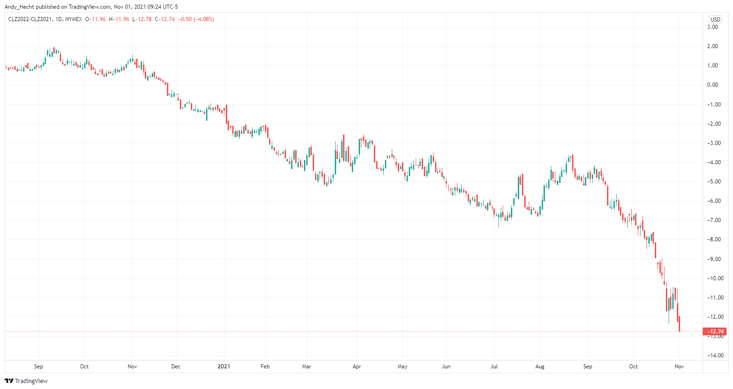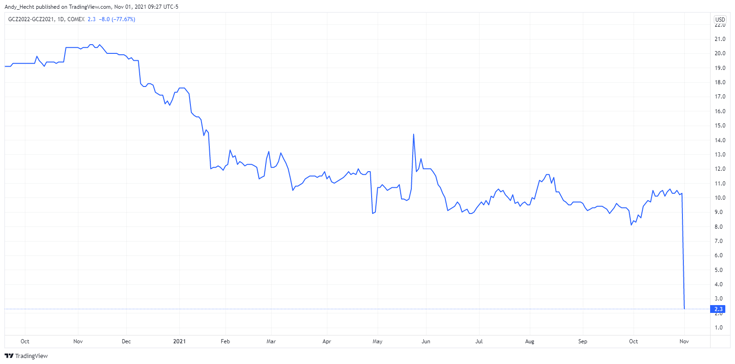November 1, 2021
Term Structures Provide Fundamental Clues
By Andrew Hecht
- Backwardation- It’s what it sounds like
- Contango- It’s not what it sounds like
- A real-time supply and demand indicator
- Commodities are unique- A mentor made a mint trading time spreads
- Time spreads can enhance your commodity trading results- The cure for low and high commodity prices
Last week, I wrote on processing spreads, a valuable tool that can provide clues about price direction. The price action in products that trade in the futures market like gasoline, heating oil, soybean meal, and soybean oil often tell us a lot about the path of least resistance for the crude oil and soybean futures contracts.
This week, I will turn my attention to term structure. Term structure is the price differential between one delivery period and another in the same commodity. Some traders call term structure time spreads, calendar spreads, front-to-back spreads, or switches. They are all the same, reflecting delivery or settlement premiums or discounts based only on time.
The late Apple founder Steve Jobs once said, “My favorite things in life don’t cost any money. It’s really clear that the most precious resource we all have is time.” While Steve Jobs was referring to his mortality, time is a critical factor in commodities.
Close attention to term structure unlocks clues about fundamental supply and demand factors.
Backwardation- It’s what it sounds like
Backwardation is a condition where commodity prices for deferred delivery are lower than for nearby delivery. A backwardation suggests that supplies are tight, forcing nearby prices higher. The condition also indicates that producers will increase output in response to a market’s deficit, leading to lower future markets.
As of the end of last week, the NYMEX crude oil futures market was in backwardation.
The chart of NYMEX WTI crude oil for delivery in December 2022 minus the price for delivery in December 2021 was trading at over a $12 per barrel backwardation or discount. December 2021 futures settled at the $83.57 level on October 29, with the December 2022 futures at the $71.33 level. Robust demand, supply concerns, and other factors have driven the spread into the widest backwardation in years and NYMEX crude oil to the highest price since 2014. Higher crude oil prices tend to support a wider backwardation. Historically, the Middle East’s political volatility has caused supply concerns at higher prices as the region is home to over half the world’s petroleum reserves.
Crude oil is one example of a raw material market where the term structure reflects supply concerns. The trend towards a wider backwardation has been bullish for the energy commodity.
Contango- It’s not what it sounds like
While backwardation is a term that reflects the spread differentials, contango is another story. In the commodities lingo world, contango is backwardation’s opposite as it reflects a market where prices for deferred delivery are higher than for nearby delivery.
Backwardation is a sign of supply concerns, whereas contango is present during periods of oversupply or equilibrium where supply and demand balance. The gold futures market is an example of a term structure in contango.
The daily chart highlights gold for delivery in December 2022 minus December 2021 is trading at a $10.30 contango or premium at the end of last week. The December 2021 futures were at the $1783.90 level, with the December 2022 contract at the $1794.20 level.
Central banks worldwide hold massive gold stocks as part of their foreign exchange reserves. Therefore, supply concerns tend to be low in the gold markets leading to a premium in its term structure. Moreover, gold has a long history as a means of exchange or money. Higher interest rates tend to push gold contangos higher.
Gold is one example of a commodity market in contango.
A real-time supply and demand indicator
A commodity’s term structure can be a helpful tool as it provides insight into supply and demand fundamentals. When a raw material price spikes higher because demand rises or supplies decline, the term structure tends to move into a widening backwardation. Producers respond by increasing output, creating the deferred discount.
When markets are in glut or oversupply conditions, producers often cut back on output, causing the chances for future deficits to develop. Thus, a steep contango can reflect the market’s perception that nearby oversupply will lead to eventual shortages.
Term structure is one of the puzzle pieces that comprise a market’s structure. The others are processing spreads, location and quality spreads, and substitution spreads.
Commodities are unique- A mentor made a mint trading time spreads
Commodities are essentials. Agricultural commodities feed and clothe the world and are increasingly providing alternative energy. Industrial commodities, including metals, energy, and minerals, are requirements for shelter, power, and infrastructure. Other raw materials have varying applications in daily life and even the financial system.
Shortages or gluts can have significant impacts on the global economy. The current inflationary pressures have roots in commodities, which had experienced price rises since the beginning of the worldwide pandemic when short-term lows gave way to bullish price action.
Supply chain bottlenecks and slowdowns or shutdowns at mines and processing facilities have put upward pressure on prices. Perhaps the most dramatic example came in the lumber futures market.
The quarterly lumber futures chart shows the price explosion to a record $1711.20 high in May 2021 on the back of slowdowns and shutdown at lumber mills and supply chain bottlenecks bringing wood to consumers during a period of rising demand. When lumber reached its May high, nearby January futures were far lower.
The chart shows January futures peaked at $1275 per 1,000 board feet, over $435 lower than the nearby contract at the May high.
When I worked at Phibro in the 1990s, my direct boss was Andy Hall, one of the most successful crude oil traders in history. While many market participants believe Mr. Hall churned out profits with long and short positions in the oil market, his greatest success came from what he called “structural risk positions.” He tended to buy the front months in the oil market and sell the deferred contracts when the market moved into contango. I remember the night when Saddam Hussein marched into Kuwait in 1990. The invasion caused the nearby price of crude oil to double in a matter of minutes.
Meanwhile, deferred oil prices declined, sending the spread to a massive backwardation. Mr. Hall pocketed hundreds of millions in profits on that night. His theory was that the risk of contango was limited over time, and the potential for spikes in backwardation increased the odds of success.
Time spreads can enhance your commodity trading results- The cure for low and high commodity prices
Commodity prices tend to rise to prices where producers increase output, consumers look for substitutes or limit buying, causing inventories to build. As supply rise to levels above demand, price find tops and reverse.
Conversely, prices tend to drop to levels where production becomes uneconomic. At low prices, consumers look to increase buying, and inventories decline, leading to price bottoms and upside reversals. The cure for high or low prices is those high or low prices in the world of commodities.
Meanwhile, highs or lows can be moving targets. As we learned in lumber and a host of other markets over the years, highs occur at levels that most analysts believe are illogical, irrational, and unreasonable. We learned the same holds on the downside as nearby NYMEX crude oil futures fell to a low of negative $40.32 per barrel in April 2020.
Time spreads can be real-time indicators of changes in a commodity’s supply and demand fundamentals. Understanding and monitoring term structure can only enhance the odds of success in the commodities asset class.
Trading advice given in this communication, if any, is based on information taken from trades and statistical services and other sources that we believe are reliable. The author does not guarantee that such information is accurate or complete and it should not be relied upon as such. Trading advice reflects the author’s good faith judgment at a specific time and is subject to change without notice. There is no guarantee that the advice the author provides will result in profitable trades. There is risk of loss in all futures and options trading. Any investment involves substantial risks, including, but not limited to, pricing volatility, inadequate liquidity, and the potential complete loss of principal. This article does not in any way constitute an offer or solicitation of an offer to buy or sell any investment, security, or commodity discussed herein, or any security in any jurisdiction in which such an offer would be unlawful under the securities laws of such jurisdiction.




